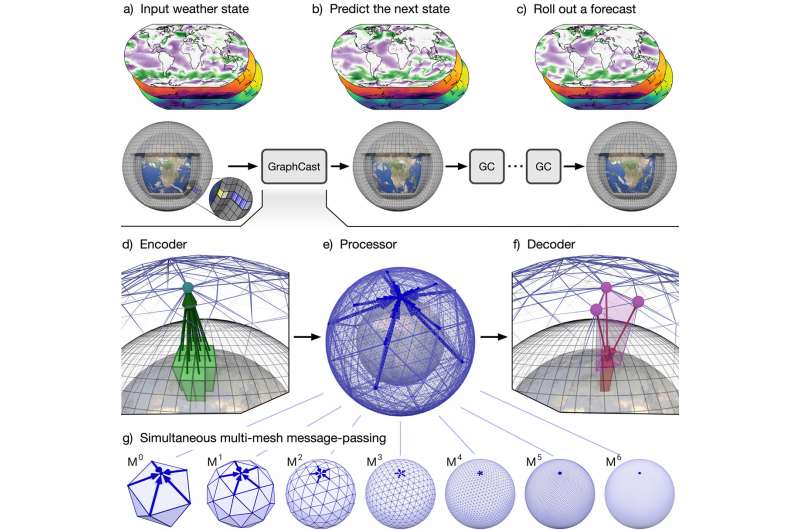November 15, 2023 report
This article has been reviewed according to Science X's editorial process and policies. Editors have highlighted the following attributes while ensuring the content's credibility:
fact-checked
peer-reviewed publication
trusted source
proofread
DeepMind tool makes 10-day weather forecast in 60 seconds

Google DeepMind researchers this week unveiled a highly accurate AI-based weather prediction model they say marks "a turning point in weather forecasting."
In an article published in Science, Remi Lam, a staff research scientist at DeepMind, said their program is faster and more accurate than current forecasting methods and can precisely pinpoint characteristics such as air pressure, temperature, humidity and wind up to 10 days in advance.
The model, GraphCast, "significantly outperforms the most accurate operational deterministic systems on 90% of 1,380 verification targets," Lam said.
The basis of weather forecasting for decades has relied on NWP (Numerical Weather Prediction) formulas, complex physics-based equations covering massive numbers of variables.
That approach sweeps through data collected by weather stations, satellites and ocean-based equipment to project trajectories of global heat, air and vapor trails. Additional input from expert analysts and constant updating of algorithms contribute to accurate output. But even with supercomputers, the entire process is time-consuming, energy-intensive and costly.
DeepMind improved on this approach by training machine-learning models with 39 years worth of weather data. Dispensing with physics-based equations, GraphCast's neural network crunches historical data at speeds 1,000 to 10,000 greater than conventional prediction systems.
Based on data from 2018, for example, GraphCast generated forecasts of the weather up to 10 days in advance in less than a minute; conventional methods would have required hours of computations. And GraphCast results were far more accurate.
"In the troposphere, which is the part of the atmosphere closest to the surface that affects us all the most, GraphCast outperforms [conventional systems] on more than 99% of measurements," Lam said.
It similarly bested conventional tools across all levels of the atmosphere in 90% of the predictions.
According to computer scientist Aditya Grover at the University of California, Los Angeles, "GraphCast currently is leading the race among the AI models."
Matthew Chantry, of the European Centre for Medium-Range Weather Forecasts, told the Financial Times that AI weather forecasting improved "far sooner and more impressively than we expected even two years ago."
GraphCast doesn't perform better than current approaches when it comes to very local forecasts, such as the chance of rain in your neighborhood. But it excels at weather events over larger areas, such as tropical cyclones and unusual swings in temperature.
"Our approach should not be regarded as a replacement for traditional weather forecasting methods," Lam said. "Rather, our work should be interpreted as evidence that [AI-assisted weather predicting] is able to meet the challenges of real-world forecasting problems and has potential to complement and improve the current best methods."
For some time, weather forecasting—as the comedian Rodney Dangerfield might have said—got "no respect." As one skeptic once put it: "The trouble with weather forecasting is that it's right too often for us to ignore it and wrong too often for us to rely on it."
George Carlin frequently mocked forecasters in his routines: "Long-range weather forecast: It's gonna get real hot, then it's gonna get real cold, then it's gonna get real hot again."
GraphCast isn't batting 1.000 quite yet, and people may still poke fun at off-base forecasters, but with the jarring speed of progress in AI systems, one prediction is certain: The future is bright and clear for AI weather predicting.
The Science article is titled "Learning skillful medium-range global weather forecasting."
More information: Remi Lam et al, Learning skillful medium-range global weather forecasting, Science (2023). DOI: 10.1126/science.adi2336
© 2023 Science X Network
















